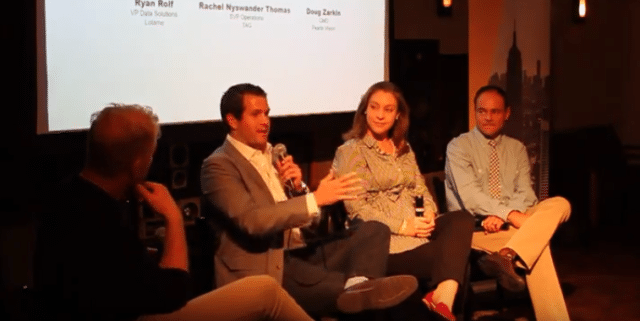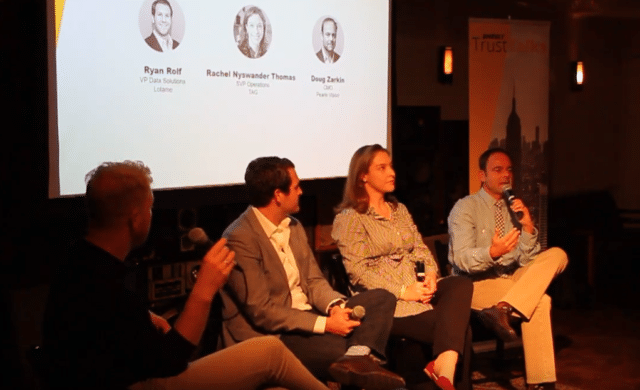Uncovering the truth behind popular programmatic myths
The programmatic advertising ecosystem can be a confusing place – so full of acronyms, vendors and platforms that it can be hard to know who (and what) you can trust. The issues of brand safety has been publicized for quite some time, and is only becoming more of a concern as programmatic buying continues to scale.
At our last Unruly Trust Talks event in New York, Unruly’s Programmatic lead Paul Gubbins sat down with Ryan Rolf, VP Data Solutions at Lotame, Rachel Nyswander Thomas, SVP Operations at TAG, and Doug Zarkin, CMO at Pearle Vision to uncover the truth behind popular programmatic myths, and how advertisers can work to rebuild trust.
Paul Gubbins (PG): Why do publishers and brands still not trust adtech vendors?
Doug Zarkin (DZ): It’s because people blindly trust technology in this space. The programmatic model is only as good as the input you put in it. One of the main flaws in the programmatic model today is that there isn’t enough of an understanding of brand intent or consumer targeting. It’s just the programmatic model says, for example, I should target blonde, blue-eyed women between the ages of 27-35 who have a poodle. There’s not enough of an understanding of the person that’s pulling those levers and making those adjustments to the programmatic model of what the brands intent is, and what reality looks like outside of the algorithm.
Rachel Nyswander Thomas (RT): I think you’re spot on, I also think there are other aspects to it. I understand brands saying they need to know everything that is happening in the programmatic model, and that is part of what TAG works on – the transparency of exactly what is going on in the supply chain. We are exactly three years old, which isn’t very long in the history of programmatic in terms of having standards by which you can judge the efficacy of your anti-fraud vendors. Yes, there are the MIC guidelines, but let’s be honest, there’s a lot more to fighting fraud than that. I think we are gaining trust back as an industry at this point. Knowing your partner’s more closely is going to be key to continuing to do that.
PG: As I think we all agree programmatic is good, but nowhere near as good as it could be, how do we fix this?
DZ: Firstly I think there are some opportunities with the agency model: we need to look at what should be done in-house and out-of-house. Secondly we need to look at the ad experience. Let’s not forget the advantage of advertising is to motivate an action, and that action comes in two ways. There has to be an emotional decision before that rational choice. One of the questions we need to ask is how do you make the advertising experience better in the digital landscape? The answer is deliver a better brief.
We have an amazing creative agency that does all our digital stuff and contrary to their earlier view, they love doing digital because they’re not confined to a 30, 60 or 15 second ad. We can create a 72, 83, or even a 2:12 second ad if we want to tell the entire story. The input that goes into any model, especially when it comes to programmatic, is only as good as the amount of time you’ve taken to write the brief. You also need to understand the emotional decision making process a consumer goes through before they make that rational choice to click on your banner and take the action.
The entity itself has to be done right before the results can come. Programmatic is simply the science. The art really comes in the ‘what’. If you are a brand in a competitive market you really need to ask yourself what your ad is saying, and communicate that in an emotive way to your consumers. Everyone says that Amazon is killing retail. They aren’t, they are just killing bad retail. The bar has been raised for all of us who are in a position to drive the ‘what’, to spend more time thinking about what the ‘what’ is, before we spend too much time thinking about ‘how’.

PG: There are now a multitude of different vendors you can work with within the advertising space. There’s no shortage of buy side vendors, of sell side vendors or of third party data vendors. How do you go about navigating that space and finding the right vendors that you can trust?
Ryan Rolf (RR): As an independent company we come up against the clouds, your Adobe, your Neilsons and this goes back to that whole idea of saying that no one ever got fired for choosing blue, and this is something we come up against all the time. The issue we have is that people don’t know us as well as they do the bigger vendors. Our main message is the fact that we really just specialise in data, and help companies untap that data, which to Doug’s point is just one piece of the puzzle. People often come to us if they are looking for that, rather than the cloud companies who have 50 other solutions that they are trying to sell them that they just don’t need.
DZ: I think brands have to come down and data suppliers and providers need to come up and be able to keep things as simple as possible. Because at the end of the day I don’t believe there is a comprehensive understanding that exists. All the problems about what websites to go to and privacy this and privacy that, those are all real issues and I’m not mitigating the impact of them, but I do not believe that the technology in those who are empowered with only the technology realise that any buyer of that technology isn’t a tech nerd.

PG: Why as an industry do you think we keep over-complicating things?
RR: I think truthfully the only reason we over-complicate things is because we keep trying to tell the story smarter than the next guy.
DZ: There’s an enormous disconnect between data and knowledge. None of us suffer from a lack of data, we live in an era of big data. We have to remember that data is only as useful as the questions you ask. Data does not make decisions. People make decisions using data, and so I think when you’re looking at vendors, whether they be big or small, you need to really look at their ability in doing that.
PG: Aare companies asking TAG the right questions around trust and transparency? Should there be a template issued by the IAB to help both buy and sell side vendors ask everybody the right information to track those insights?
RT: The conversation has to be very unique between partners. Everyone knows we certify organisations but a big part of what we focus on is not just are you certified or not, it’s connecting the dots between partners and encouraging them to get to know each other better beyond just seeing whether a company is certified or not. At the moment within this industry brand safety means something different to everyone. We need to dig further into what the advertiser actually wants and what does the publisher actually have to offer, that transparency and connection is vital, a checklist can only go so far.

